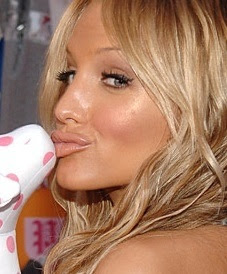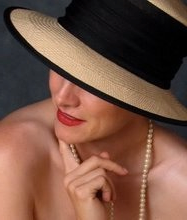
 Twenty-two-year-old Ashlee Simpson. And who is listening? Her fan base, the ashlee rocks she's the best i am a big fan if i could ever say any thing 2 ashlee it would be keep goin cuz ur good at wut u do crowd.
Twenty-two-year-old Ashlee Simpson. And who is listening? Her fan base, the ashlee rocks she's the best i am a big fan if i could ever say any thing 2 ashlee it would be keep goin cuz ur good at wut u do crowd.

 It's a quote in this month's Harper's Bazaar profile featuring "Ashlee Simpson's New Look" and "chic new image." It gushes on: "gone is the girl with the heavy black eyeliner, punky clothes, and teen angst. In her place is a 22-year-old woman who finally feels comfortable in her own skin." Gone also is the hump on her nose, the thin lips, and underdeveloped jawline.
It's a quote in this month's Harper's Bazaar profile featuring "Ashlee Simpson's New Look" and "chic new image." It gushes on: "gone is the girl with the heavy black eyeliner, punky clothes, and teen angst. In her place is a 22-year-old woman who finally feels comfortable in her own skin." Gone also is the hump on her nose, the thin lips, and underdeveloped jawline.She looks remade in an oddly Paris Hilton way.
 Yet the July 2006 edition of Marie Claire featured a pre-rhinoplasty & -genioplasty Simpson saying, "everyone is made differently, and that is what makes us beautiful and unique. I want girls to look in the mirror and feel confident." While the magazine cover was on the presses, Simpson underwent a hump reduction rhinoplasty and acquired a more defined mandibular angle via implants (April 2006). And do you really think this nose job was her first foray into plastic surgery? Anything catch your eye in this youthful handstand?
Yet the July 2006 edition of Marie Claire featured a pre-rhinoplasty & -genioplasty Simpson saying, "everyone is made differently, and that is what makes us beautiful and unique. I want girls to look in the mirror and feel confident." While the magazine cover was on the presses, Simpson underwent a hump reduction rhinoplasty and acquired a more defined mandibular angle via implants (April 2006). And do you really think this nose job was her first foray into plastic surgery? Anything catch your eye in this youthful handstand?What do you think speaks the loudest to teen fans: action or words?
In fact, there has been a jump in teenage consumers of cosmetic surgery. Overall, American teens opt most often for the nonsurgical procedures of laser hair removal and microdermabrasion, followed by rhinoplastic surgery in third place. However, teen breast augmentation has greatly increased in recent years as a result of widespread societal influences.
Overall, the US consumes nearly double the number of cosmetic procedures of the next nearest competitor (Mexico) at a price tag of $12.4 billion dollars.
Are children emotionally scarred by physical variations considered normal a mere generation ago? Most teens desire cosmetic surgery in order to "fit in." Self-esteem and confidence hinge more on this social peer factor than on appearance per se. Yet critics of elective aesthetic surgery focus on the immaturity risk for teenagers: their bodies are still growing, changing, and developing as are their motivations. Far less is said or written about the possibly that cosmetic surgery may distort their emotional growth into adulthood.
Apologists always trot out the example of a young male with breast tissue or gynecomastia caused by puberty, rationalizing that a surgeon can remove the tissue before the teen reaches a blighted adulthood (when it generally resolves on its own). For this reason it's rarely performed on teenagers. Otoplasty (ear pinning) is another old warhorse, but generally this procedure is done early, well before the teenage years.
In reality, elective asthetic teenage surgery is by and large the domain of girls. And what happens to the psyche of the female child who undergoes cosmetic surgery? Is all the adult blather about loving yourself and it's-what's-on-the-inside-that-counts just that: a lie? Make no doubt about it, this surgical trend is intimately tied up with how women and girls are treated in American society. Very few teenage boys make the request or profess the need for cosmetic surgery.
The ASPS's published but informal position is that cosmetic surgery is appropriate with parental consent if the teenager: 1) "initiates the request," 2) "possesses realistic goals," and 3) "has sufficient maturity." As parents, what are we to make of this? Teens universally master the art of pestering for what they want loooong before age 18. What about the other two criteria? Is any child of 16 or 17 capable of making a permanent choice about their nose? How many of us adults wear the fashions we once loved at that age? What if those tie-dyed bell bottomed jeans were surgically affixed to our aging ass for the next 50 years? Would we congratulate ourselves on our teen-aged wisdom and foresight?
And is 18 even a magic number? Most of us make fairly significant mistakes well into the age of emancipation without undergoing surgery. The issue of parental consent is fraught with emotional baggage. Is the "yes" based on wanting to please the child? Or a rationalization of what's good for the goose (mother) is good for the gosling? Or a leftover parental longing to "fit in" with the cool crowd? Why would a responsible parent say yes?
So, back to Ashlee Simpson and her answer to teenage angst: is surgically conforming to a transient aesthetic norm really what it means to mature into a woman who feels comfortable in her own skin? Tell us what you think.
Hear Anne live on the Kevyn Burger show Thursdays featuring Knifestyles of the Rich & Famous.





